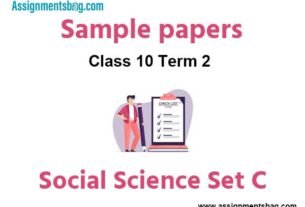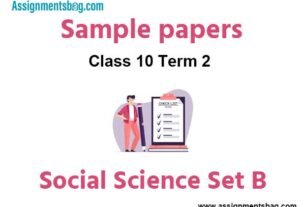Please refer to CBSE Class 10 Science Case Studies provided below for latest examinations. These Case Study with questions and answers have been prepared based on the chapters in your Class 10 Science book. All Class 10 Science Important Questions and case studies with solutions have been prepared as per the latest examination syllabus and guidelines issued by CBSE, NCERT and KVS.
Case Study for Class 10 Science
Read the following and answer any four questions
The reaction between MnO2 with HCl is depicted in the following diagram. It was observed that a gas with bleaching abilities was released .

Question. Identify the correct statement from the following:
MnO2 is getting reduced whereas HCl is getting oxidized
a) MnO2 is getting oxidized whereas HCl is getting reduced.
b) MnO2 and HCl both are getting reduced.
c) MnO2 and HCl both are getting oxidized.
Answer
A
Question. Chlorine gas reacts with _______ to form bleaching powder.
a) dry Ca(OH)2
b) dil. solution of Ca(OH)
c) conc. solution of Ca(OH)
d) dry CaO
Answer
A
Question. In the above discussed reaction, what is the nature of MnO2 ?
a) Acidic oxide
b) Basic oxide
c) Neutral oxide
d) Amphoteric oxide
Answer
B
Question. The chemical reaction between MnO
a) displacement reaction
b) combination reaction
c) redox reaction
d) decomposition reaction.
Answer
C
Question. What will happen if we take dry HCl gas instead of aqueous solution of HCl?
a) Reaction will occur faster.
b) Reaction will not occur.
c) Reaction rate will be slow
d) Reaction rate will remain the same.
Answer
B
Read the following and answer any FOUR questions from 5.1 to 5.5 that follow on the basis of information provided and studied concepts.
A biogas plant is where biogas is produced by fermenting biomass.
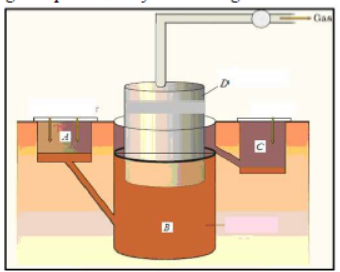
Question. Biogas is formed in the
a) presence of air only
b) presence of water only
c) presence of air and absence of water
d) presence of water and absence of air.
Answer
D
Question. Which one of the following is NOT correct for biogas
a) its carbon neutral
b) its non-renewable
c) it depends on micro-organisms
d) yields rich manure
Answer
B
Question. Which of the following best indicates the steps of
a) Waste watezr feed → biogas storage → generator → biogas
b) Waste water feed → digester → biogas → biogas storage → generator
c) Generator → waste water feed → digester → biogas → biogas storage
d) Waste water feed → biogas → digester → biogas storage → generator
Answer
B
Question. In which of the parts would you find anaerobic bacteria
a) A
b) B
c) C
d) D
Answer
B
Question. Biogas is a better fuel than animal dung cake because
a) Biogas is a renewable source of energy
b) Animal dung cake has higher calorific value
c) Biogas has high heating capacity
d) Biogas burns without smoke.
i. (a) only
ii. (b) only
iii. (c) and (d)
iv. (a) and (b)
Answer
C
Waste management is essential in today’s society. Due to an increase in population, the generation of waste is getting doubled day by day. Moreover, the increase in waste is affecting the lives of many people.
Waste management is the managing of waste by disposal and recycling of it. Moreover, waste management needs proper techniques keeping in mind the environmental situations. For instance, there are various methods and techniques by which the waste is disposed of. You must have come across 5 R’s to save the environment: refuse, reduce, reuse, repurpose and recycle.
Question. Choose the waste management strategy that is matched with correct example.
| a) | Refuse | Choose products that use less packaging |
| b) | Reduce | Give unwanted toys and books to hospitals or schools |
| c) | Reuse | Not using single use plastic |
| d) | Repurpose | Making flower pot from used plastic bottle |
Answer
D
Question. According to the ‘Solid Waste Management Rule 2016’, the waste should be segregated into three categories. Observe the table below and select the row that has correct information
| Wet waste | Dry waste | Hazardous waste | |
| a) | Cooked food, vegetable peels | Used bulbs, fluorescent lamps | Plastic carry bags, bottles, newspaper, cardboard |
| b) | Coffee and tea powder, garden waste | Plastic carry bags, bottles, newspaper, cardboard | Expired medicines, razors, paint cans |
| c) | Leftover food, vegetable peels | Coffee and tea powder, garden waste | Insect repellents, cleaning solutions |
| d) | Uncooked food, tea leaves | Old crockery, frying pans | Coffee and tea powder, garden waste |
Answer
B
Question. Effective segregation of wastes at the point of generation is very important. Select the appropriate statements giving the importance of waste segregation.
i) less waste goes to the landfills
ii) better for public health and the environment
iii) help in reducing the waste
iv) resulting in deterioration of a waste picker’s health
a) both i) and ii)
b) both i) and iii)
c) both ii) and iii)
d) both i) and iv)
Answer
A
Question. Recycling of paper is a good practice but recycled paper should not be used as food packaging because
a) recycled papers take lots of space
b) recycled papers can’t cover food properly
c) recycled papers can cause infection
d) recycled papers are costly
Answer
C
Question. The given graph shows the amount of waste generated, dumped and treated in percentage. Identify the reason of low success rate of waste management process.

a) only 15% of urban India’s waste is processed
b) less than 60% of waste is collected from households
c) more than 60% of waste is collected from households
d) both a and b
Answer
D
Read the following and answer any four questions from 1.1 to 1.5:
Marble’s popularity began in ancient Rome and Greece, where white and off-white marble were used to construct a variety of structures, from hand-held sculptures to massive pillars and buildings.

Question. Calcium oxide can be reduced to calcium, by heating with sodium metal. Which compound would act as an oxidizing agent in the above process?
a) Sodium
b) sodium oxide
c) calcium
d) calcium oxide
Answer
D
Question. A student added 10g of calcium carbonate in a rigid container, secured it tightly and started to heat it. After some time, an increase in pressure was observed, the pressure reading was then noted at intervals of 5 mins and plotted against time, in a graph as shown below. During which time interval did maximum decomposition took place?

a) 15-20 min
b) 10-15 min
c) 5-10 min
d) 0-5 min
Answer
D
Question. Marble statues are corroded or stained when they repeatedly come into contact with polluted rain water. Identify the main reason
a) decomposition of calcium carbonate to calcium oxide
b) polluted water is basic in nature hence it reacts with calcium carbonate
c) polluted water is acidic in nature he
d) calcium carbonate dissolves in water to give calcium hydroxide.
Answer
C
Question. The substance not likely to contain CaCO3 is
a) Dolomite
b) A marble statue
c) Calcined gypsum
d) Sea shells.
Answer
B
Question. Gas A, obtained above is a reactant for a very important biochemical process which occurs in the presence of sunlight. Identify the name of the process –
a) Respiration
b) Photosynthesis
c) Transpiration
d) sphotolysis
Answer
B
Read the following and answer the questions any four from (i) to (v)
Food chains are very important for the survival of most species. When only one element is removed from the food chain it can result in extinction of a species in some cases. The foundation of the food chain consists of primary producers.
Primary producers, or autotrophs, can use either solar energy or chemical energy to create complex organic compounds, whereas species at higher trophic levels cannot and so must consume producers or other life that itself consumes producers. Because the sun’s light is necessary for photosynthesis, most life could not exist if the sun disappeared. Even so, it has recently been discovered that there are some forms of life, chemotrophs, that appear to gain all their metabolic energy from chemosythesis driven by hydrothermal vents, thus showing that some life may not require solar energy to thrive.

Question.1 If 10,000 J solar energy falls on green plants in a terrestrial ecosystem, what percentage of solar energy will be converted into food energy?
a) 10,000 J
b) 100 J
c) 1000 J
d) It will depend on the type of the terrestrial plant.
Answer
B
Question. Mr. X is eating curd/yogurt. For this food intake in a food chain he should be considered as occupying
a) First trophic level
b) Second trophic level
c) Third trophic level
d) Fourth trophic level
Answer
C
Question. The decomposers are not included in the food chain.
The correct reason for the same is because decomposers:
a) Act at every trophic level of the food chain
b) Do not breakdown organic compounds
c) Convert organic material to inorganic forms
d) Release enzymes outside their body to convert organic material to inorganic forms
Answer
A
Question. Matter and energy are two fundamental inputs of an ecosystem. Movement of
a) Energy is bidirectional and matter is repeatedly circulating.
b) Energy is repeatedly circulation and matter is unidirectional.
c) Energy is unidirectional and matter is repeatedly circulating.
d) Energy is multidirectional and matter is bidirectional.
Answer
C
Question. Which of the following limits the number of trophic levels in a food chain?
a) Decrease in energy at higher trophic levels
b) Less availability of food
c) Polluted air
d) Water
Answer
A
Read the following and answer the questions any four from (i) to (v)
Observe the food web and answer the questions given below –

Question. Why do all food chains start with plants?
a) Because plants are easily grown
b) Because plants are nutritious
c) Because plants can produce its own energy
d) Because plants do not require energy
Answer
C
Question. Which trophic level is incorrectly defined?
a) Carnivores – secondary or tertiary consumers
b) Decomposers – microbial heterotrophs
c) Herbivores – primary consumers
d) Omnivores – molds, yeast and mushrooms
Answer
D
Question. The given figure best represents:
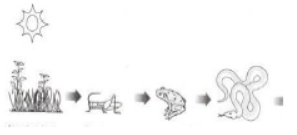
a) Grassland food chain
b) Parasitic food chain
c) Forest food chain
d) Aquatic food chain
Answer
A
Question. The mussel can be described as
a) Producer
b) Primary consumer
c) Secondary consumer
d) decomposer
Answer
C
Question. In the food web, what two organisms are competing for food?

a) A and B
c) A and C
b) D and F
d) B and D
Answer
D
Read the following and answer any four questions from 3.1 to 3.5:
Chemistry in Automobiles:
For an internal combustion engine to move a vehicle down the road, it must convert the energy stored in the fuel into mechanical energy to drive the wheels. In your car, the distributor and battery provide this starting energy by creating an electrical “spark”, which helps in combustion of fuels like gasoline. Below is the reaction depicting complete combustion of gasoline in full supply of air :

Question. ‘A student while walking on the road observed that a cloud of black smoke belched out from the exhaust stack of moving trucks on the road.’ Choose the correct reason for the production of black smoke:
a) Limited supply of air leads to incomplete combustion of
b) Rich supply of air leads to complete combustion of fuel.
c) Rich supply of air leads to a combination reaction.
d) Limited supply of air leads to complete combustion of fuel.
Answer
A
Question. Identify the types of chemical reaction occurring during the combustion of fuel:
a) Oxidation & Endothermic reaction
b) Decomposition & Exothermic reaction
c) Oxidation & Exothermic reaction
d) Combination & Endothermic reaction
Answer
C
Question. On the basis of evolution/absorption of energy, which of the following processes are similar to combustion of fuel?
a) Photosynthesis in plants
b) Respiration in the human body
c) Decomposition of vegetable matter
d) Decomposition of ferrous sulphate.
(a) (ii) & (iii)
(b) (i) & (ii)
(c) (iii) & (iv)
(d) (ii) & (i)
Answer
A
Question. Which of the following are the products obtained from the reaction mentioned in the above case?
Product ‘X’Product ‘Y’
a) CO2 H2O2
b) H2O CO
c) CH3OH H2O
d) CO2 H2O
Answer
D
Question. ‘Although nitrogen is the most abundant gas in the atmosphere, it does not combustion’. Identify the correct reason for this statement.
a) Nitrogen is a reactive gas
b) Nitrogen is an inert gas
c) Nitrogen is an explosive gas
d) Only hydrocarbons can take part in combustion
Answer
B
Read the following and answer the questions any four from (i) to (v)
Biosphere is a global ecosystem composed of living organisms and abiotic factors from which they derive energy and nutrients. And ecosystem is defined as structural and functional unit of the biosphere comprising of living and non-living environment that interact by means of food chains and chemical cycles resulting in energy flow, biotic diversity and material cycling to form a stable, self-supporting system.

Question. Consider the following statements concerning food chains:
(i) Removal of 80% tigers from an area resulted in greatly increased growth of vegetation
(ii) Removal of most of the carnivores resulted in an increased population of herbivores.
(iii) The length of the food chains is generally limited to 3 – 4 trophic levels due to energy loss
(iv) The length of the food chains may vary from 2 to 8 trophic levels
Which two of the above statements are correct?
a) (i), (iv)
b) (i), (ii)
c) (ii), (iii)
d) (iii), (iv)
Answer
C
Question. The diagram below shows a food web from the sea shore
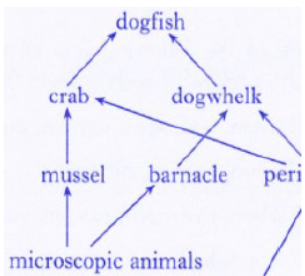
The mussel can be described as
a) Producer
b) Primary consumer
c) Secondary consumer
d) Decomposer
Answer
C
Question. The given figure best represents:

a) Grassland food chain
b) Parasitic food chain
c) Forest food chain
d) Aquatic food chain
Answer
A
Question. Which trophic level is incorrectly defined?
a) Carnivores – secondary or tertiary consumers
b) Decomposers – microbial heterotrophs
c) Herbivores – primary consumers
d) Omnivores – molds, yeast and mushrooms
Answer
D
Question. Which of the following group of organisms are not included in ecological food chain?
a) Carnivores
b) Saprophytes
c) Herbivores
d) Predators
Answer
B
Read the following and answer any four questions from Frothing in Yamuna:
The primary reason behind the formation of the toxic foam is high phosphate content in the wastewater because of detergents used in dyeing industries, dhobi ghat Yamuna’s pollution level is so bad that parts of it have been labelled ‘dead’ as there is no oxygen in it for aquatic life to survive.
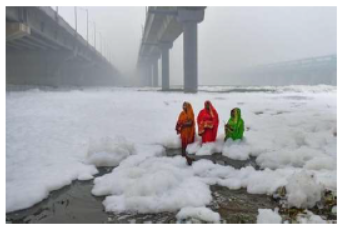
Question. High content of phosphate ion in river Yamuna may lead to:
a) decreased level of dissolved oxygen and increased growth of algae
b) decreased level of dissolved oxygen and no effect of growth of algae
c) increased level of dissolved oxygen and increased growth of algae
d) decreased level of dissolved oxygen and decreased growth of algae
Answer
A
Question. Which of the following statements is correct for the water with detergents dissolved in it?
a) low concentration of hydroxide ion (OH- )and high concentration of hydronium ion (H3O+)
b) high concentration of hydroxide ion (OH- )and low concentration of hydronium ion (H3O+)
c) high concentration of hydroxide ion (OH-) as well as hydronium ion (H3O+)
d) equal concentration of both hydroxide ion (OH-) and hydronium ion (H3O+).
Answer
B
Question. The table provides the pH value of four solutions P, Q, R and S
| Solution | pH value |
| P | 2 |
| Q | 9 |
| R | 5 |
| S | 11 |
Which of the following correctly represents the solutions in increasing order of their hydronium ion concentration?
a) P>Q>R>S
b) P>S>Q>R
c) S<Q<R<P
d) S<P<Q<R
Answer
C
Question. Predict the pH value of the water of river Yamuna if the reason for froth is high content of detergents dissolved in it.
a) 10-11
b) 5-7
c) 2-5
d) 7
Answer
A
Question. If a sample of water containing detergents is provided to you, which of the following methods will you adopt to neutralize it?
a) Treating the water with baking soda
b) Treating the water with vinegar
c) Treating the water with caustic soda
d) Treating the water with washing soda
Answer
B
Read the following and answer the questions any four from (i) to (v)
Food chains are very important for the survival of most species.
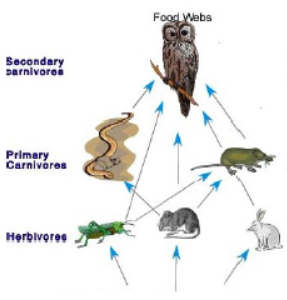
Question. The decomposers are not included in the food chain.The correct reason for the same is because decomposers:
a) Act at every trophic level of the food chain
b) Do not breakdown organic compounds
c) Convert organic material to inorganic forms
d) Release enzymes outside their body to convert organic material to inorganic forms
Answer
A
Question. If Ravi is consuming curd/yogurt for lunch , which trophic level in a food chain he should be considered as occupying ?
a) First trophic level
b) Second trophic level
c) Third trophic level
d) Fourth trophic level
Answer
C
Question. Matter and energy are two fundamental inputs of an ecosystem. Movement of
a) Energy is bidirectional and matter is repeatedly circulating.
b) Energy is repeatedly circulation and matter is unidirectional.
c) Energy is unidirectional and matter is repeatedly circulating.
d) Energy is multidirectional and matter is bidirectional.
Answer
C
Question. If 10,000 J solar energy falls on green plants in a terrestrial ecosystem, what percentage of solar energy will be converted into food energy?
a) 10,000 J
b) 100 J
c) 1000 J
d) It will depend on the type of the terrestrial plant.
Answer
B
Question. Which of the following limits the number of trophic levels in a food chain?
a) Decrease in energy at higher trophic levels
b) Less availability of food
c) Polluted air
d) Water
Answer
A
Observe the following diagram and answer the questions any four from (i) to (v)
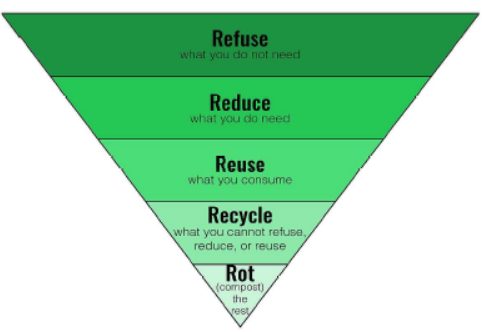
Question. Choose the waste management strategy that is matched with correct example.
| a) | Refuse | Choose products that use less packaging |
| b) | Reduce | Give unwanted toys and books to hospitals or schools |
| c) | Reuse | Not using single use plastic |
| d) | Repurpose | Making flower pot from used plastic bottle |
Answer
D
Question. Effective segregation of wastes at the point of generation is very important. Select the appropriate statements giving the importance of waste segregation.
i) less waste goes to the landfills
ii) better for public health and the environment
iii) help in reducing the waste
iv) resulting in deterioration of a waste picker’s health
a) both i) and ii)
b) both i) and iii)
c) both ii) and iii)
d) both i) and iv)
Answer
A
Question. According to the ‘Solid Waste Management Rule 2016’, the waste should be segregated into three categories. Observe the table below and select the row that has correct information
| Wet waste | Dry waste | Hazardous waste | |
| a) | Cooked food, vegetable peels | Used bulbs, fluorescent lamps | Plastic carry bags, bottles, newspaper, cardboard |
| b) | Coffee and tea powder, garden waste | Plastic carry bags, bottles, newspaper, cardboard | Expired medicines, razors, paint cans |
| c) | Leftover food, vegetable peels | Coffee and tea powder, garden waste | Insect repellents, cleaning solutions |
| d) | Uncooked food, tea leaves | Old crockery, frying pans | Coffee and tea powder, garden waste |
Answer
B
Question. Recycling of paper is a good practice but recycled paper should not be used as food packaging because
a) recycled papers may release color /dyes on food items
b) recycled papers are not absorbent
c) recycled papers can cause infection due to release of methane
d) recycled papers are costly
Answer
C
Question. When recycling a plastic water bottle, what should you do with the cap?
a) The cap goes into a garbage can and the bottle goes in a recycling bin
b) Screw the cap back on the bottle, then put the bottle and cap in a recycling bin
c) Screw the cap back on the bottle, then put the bottle and cap in the garbage can
d) Recycle the cap separately.
Answer
A
Read the following and answer any FOUR questions from 9.1 to 9.5 that follow on the basis of information provided and studied concepts.
In Kunjpura village, located in Karnal district, Haryana, AdityaAggarwal and his older brother AmitAggarwal run Tee Cee Industries, a steel plant set up by their ancestors in 1984. Along with this, they also run a gaushala that houses 1,200 cows that can no longer produce milk.
The cow shelter was manageable but running the steel plant was turning out to be expensive because they spent a whopping Rs 5 lakh every month on electricity.
The brothers struck upon an idea. Why not run the factory with the biogas produced from cow dung from the shelter and other gaushalas, along with bio and agri
led Aditya and Amit to start AmritFertilisers, a biogas project, in 2014, without any government support.
Question. The correct labelling in a biogas plant is given in

Answer
B
Question. Raw material used in bio gas plant is
(a) Animal dung
(b) crop residue
(c) Food waste
(d) All of the above
Answer
D
Question. Biogas is a better fuel than animal dung cake because
(i) Biogas has lower calorific value.
(ii) Animal dung cake has higher calorific value.
(iii) Biogas has high heating capacity.
(iv) Biogas burns without smoke.
(a) (i) only
(b) (ii) only
(c) (iii) and (iv)
(d) (i) and (ii)
Answer
C
Question. Biogas is a mixture of the following gases.
(a) Ethane,Carbon monoxide, Nitrogen and Butane
(b) Methane,Hydrogen,Carbon dioxide and Nitrogen
(c) Butane,Carbon monoxide,Propane and Hydrogen
(d) Carbon monoxide,Sulphur dioxide and Hydrogen
Answer
B
Question. Biogas is formed in the
(a) presence of air only.
(b) presence of water only.
(c) absence of air only.
(d) presence of water and absence of air.
Answer
D

